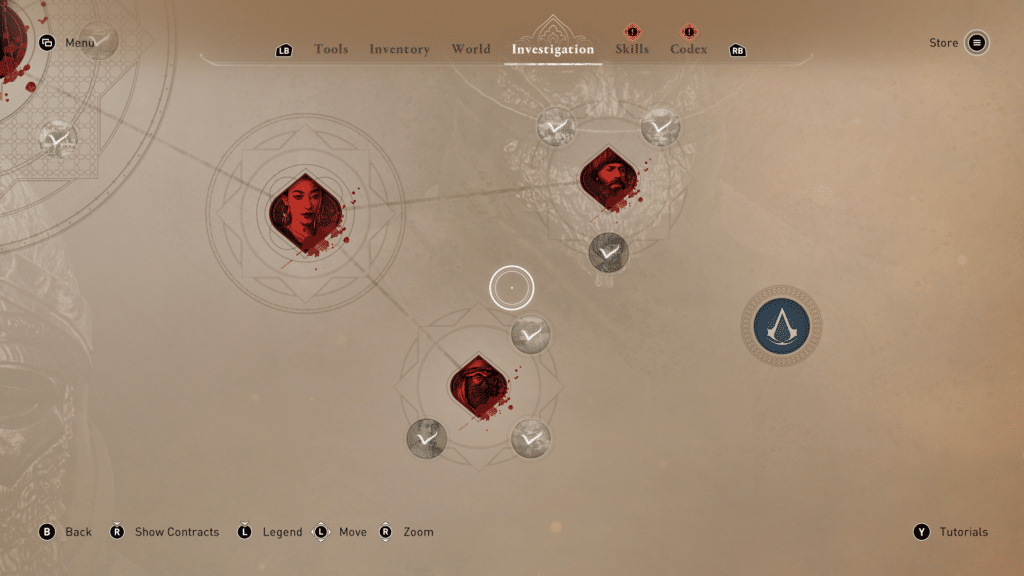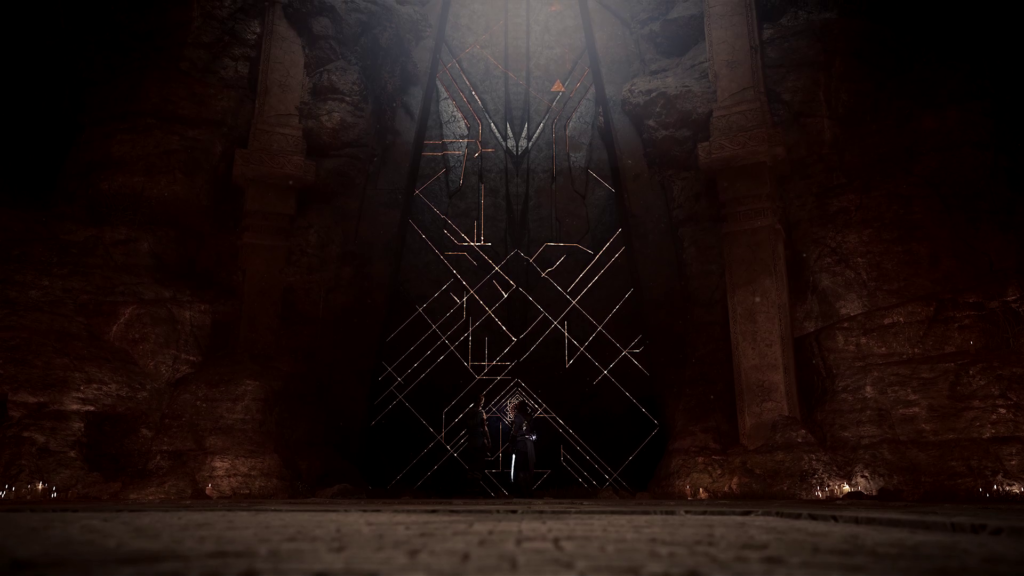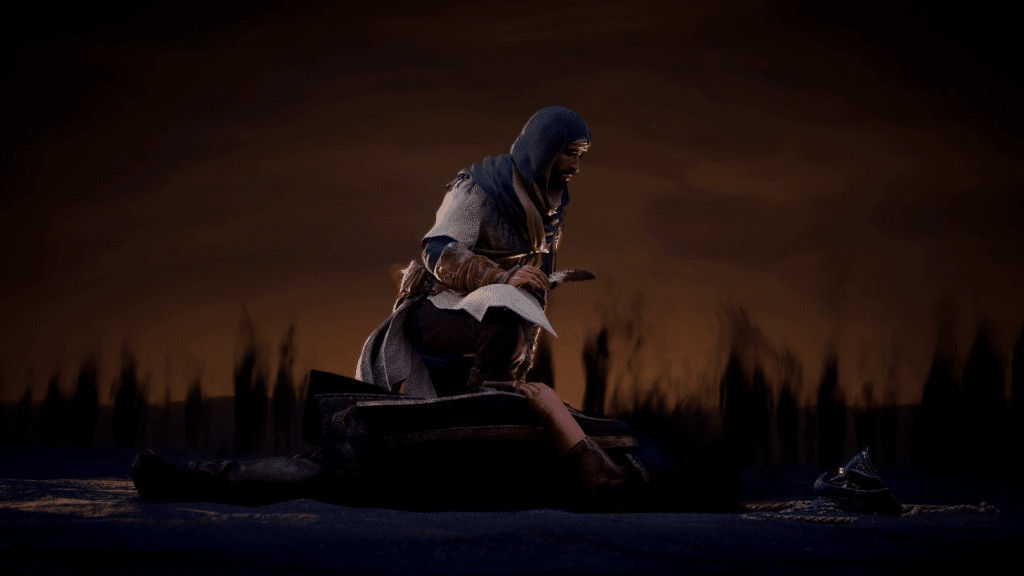Assassin’s Creed as a franchise has come a long way since the launch of its first title in 2007, with Assassin’s Creed: Mirage marking the thirteenth main entry title amidst countless spin-offs. The developers have opted to return to the smaller scale, stealth-driven gameplay of the earlier entries while maintaining the improved mechanics that have allowed the recent trilogy of RPG-heavy elements to give the franchise a second wind. Taking place in 9th century Baghdad and following Basim Ibn Ishaq, a character first introduced in 2020’s Assassin’s Creed: Valhalla, Mirage once again reignites the eternal struggle between the Hidden Ones and the Order of the Ancients. Leaving behind his street-thief upbringing to undergo training with the Hidden Ones to become a master assassin, Basim’s coming-of-age adventure is a clever collision of the franchise’s origins and its future.
Reining in the scope of recent entries allows Assassin’s Creed: Mirage to breathe more confidently and focus the action in a more calculated direction without the gigantic landscapes that were the backdrops of Origins, Odyssey and Valhalla. Taking place nearly 10 years prior to Basim’s introduction in Valhalla, Baghdad is still an impressive size, full of several key locations that offer collectibles, lore and optional quests to keep the player realising the open-world format, albeit smaller than we have become accustomed to. Assassin’s Creed: Mirage feels familiar yet different, paying homage to what made the franchise a hit nearly two decades ago while establishing a refined overall gameplay experience that ultimately feels like a step in the right direction on most fronts.
One of the first notable differences between Mirage and previous entries in the franchise is the restructuring of how the main quest plays out. The traditional structure of main quests has been replaced with ‘Cases’ comprised of multiple ‘Investigations’. The Hidden Ones have four bureaus spread throughout the map that each have a couple of Cases, and these don’t have to be completed in any set order. All four can be visited for the first time at any point and the Cases associated to them are revealed, though the order of which to complete them is entirely up to the player.

While the freedom to tackle the story in a non-linear structure sounds liberating, it actually significantly hinders the pacing of the broader narrative arc as each of the Cases is very self-contained. Minimal overarching story threads are mentioned due to the lack of linear structure, meaning certain events that have happened may seem relevant and important, but can’t be brought up as the game doesn’t know what the player has done outside of that specific quest line. This leaves large gaps between key events being mentioned by Basim’s cast of supporting characters which prevents the bigger picture from ever feeling like the high stakes dramas the franchise has built its foundations on. The absence of dramatic, action-packed set pieces is another noticeable change that prevents any moments that precede the final minutes from standing out as particularly memorable.
The underlying story itself of Basim’s rise through the ranks of the Hidden Ones and his journey of self-discovery is far more interesting than the political power plays tied to each of the key assassinations of the Order of the Ancients’ biggest players. Basim’s story is intriguing and is built upon in bite size portions that will leave the player wanting more, culminating in an exciting ending that has ramifications for not just his character’s past, present and future but that of the franchise as a whole.

The story that unravels within each Case lacks the same energy or intrigue and merely sets Basim up to investigate mysterious figures and happenings before identifying his target and being assigned to take them out. Given the reinvigorated attention of recent entries to the present-day timeline it was very surprising to see that there was absolutely no present-day action, further limiting the scope of Mirage in the broader sense.
Coming in at a leisurely 10-12 hours if the player is just focusing on the story is a refreshing change of pace for the gigantic entries that preceded it. That play time could easily be doubled by fully exploring the world on offer and uncovering all of its secrets and collectibles hidden high and low.

Combat, platforming and environmental traversal are at the heart of every Assassin’s Creed, and Mirage is no different. Each aspect has improved significantly over the years but for the first time since the combat system was overhauled with 2017’s Origins, combat doesn’t feel as seamless. With light and heavy strikes to manage with stamina, parrying, evading and quick-fire throwable items, combat is varied enough to remain interesting. The tight timing windows to execute successful parries and evasions is stricter than fans of the franchise are familiar with, and this will likely be difficult to master for casual players. Hacking and slashing worked in previous entries, but Mirage requires more patience and a bit of skill.
Blow-darts that render enemies unconscious, throwing knives, noisemakers to lure guards and smoke bombs are just a few of the quick throw items available to Basim, more can be unlocked and all of them can be upgraded. These each have useful parts to play in combat and stealth, with some positioning enemy guards to sneak past while they are distracted, to take them down in active combat or to use as a means to escape if the situation becomes too overwhelming.

Complimenting the melee weapons and ranged throwable items in combat is a skill tree with three branches that essentially represent stealth, tools and reconnaissance. As with the rest of Mirage, the skill tree too has been refined into a considerably smaller scope that places heavy emphasis on stealth and observation, especially in regard to Basim’s trusty eagle, Enkidu. Enkidu can be controlled and utilised to mark enemies and identify points of interest and quest objectives, with its effectiveness and scope upgraded within the skill tree. Enemy archer’s can detect Enkidu until they have been neutralised, making the skies once again safe for the eagle to do its work.

Parkour feels great and scaling buildings, traversing platforms and outrunning enemies is as seamless as ever. As has always been the issue with traversal, it is extremely easy to accidentally have Basim do something that isn’t intended such as jumping to the wrong ledge, jumping off things or simply not responding as he should to the control inputs. This isn’t a new issue, but it does seem slightly less prevalent than usual. For better or worse, Assassin control issues have essentially become a feature for the series rather than a bug.

Weapons can be upgraded at Blacksmiths which increase their damage output and defence. Outfits offer unique perks which enhance Basim’s perks and can be upgraded at Tailors scattered across the world. Tailors can also switch the appearance of the outfit to another owned outfit while maintaining the stats and passive works of the original, referred to as transmogrification. This allows players to keep their Basim looking the way they want without having to wear an outfit they don’t like just because the stats are better. Costumes can also be unlocked and equipped at any time, overriding the currently equipped outfit while maintaining the stats, just like the previously mentioned transmog system at the Tailors. Swords and daggers can also utilise transmog.

Playing the story in an Assassin’s Creed title is just one part of the experience, and an argument could easily be made that exploration and collectibles are equally vital to the enjoyment. Baghdad is broken into several explorable districts and includes vast sand dunes, towns, villages and dense flora populated areas. Riddled with lore and collectibles to find, secrets to unlock and synchronisation points to reveal everything in sight keeps players engaged regardless of how they choose to experience the game, be it story first, exploration first or a healthy balance of the two.

Some truly stunning environments and meticulously created sandboxes are a visual delight, painting 9th century Baghdad as a place livelier than one the player may have expected. Lush greenery is peppered throughout the beige-toned towns, and lakes and rivers further animate the metaphorical canvas with a vibrance that paint a beautiful backdrop to the stealth-assassination heavy experience that results in bloodshed. Character models look excellent, easily the best in the series and they are emotionally animated to feel like meaningful companions and adversaries to Basim’s odyssey.
A beautiful score and sharp, snappy sound effects punctuate the dramatic beats and action respectively in a way the franchise has become known for. Whether people love the series through its evolution or have become alienated by the change of direction, the audio-visual presentation of Assassin’s Creed is always on point, and Mirage is no exception.

Review by Games of DAYNE
Games of DAYNE’s written works can also be found at his website HERE.
* A digital code for Assassins Creed: Mirage was kindly provided to Xbox Gamer Dad for the purpose of this review. *
Summary
Assassin’s Creed: Mirage is admittedly a departure from what the series has become in terms of scope and ambition to deliver a world that’s designed to draw players back over lengthy periods of time. The tighter focus in terms of the size of everything is a risk that certainly pays off as the overall experience feels sharper and more concentrated than ever before, harkening back to the simpler times of the original few titles. Replacing the hack and slash approach to combat with a heavier emphasis on stealth is also welcome, again highlighting the very nature of the Assassin order that Basim, and those we have played as before him, represent. A few minor missteps with combat and narrative structure aside, Assassin’s Creed: Mirage is ultimately a step in the right direction for the franchise.
PROS
- The return of stealth-focused combat
- Smaller scale across the board is much more accessible
- Clever conclusion to the story
- Beautiful environments
CONS
- Case/Investigation structure less compelling than traditional main story quests
- Non-linear approach to story hinders momentum and pacing
- Lacks memorable moments and set pieces the franchise has thrived with

